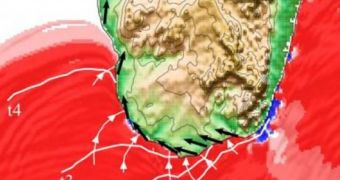Over the past few years, a growing number of researchers around the world have argued that the “U” and “V”-shaped structures – also known as chevrons – that can be seen on some coastal lines are the result of megatsunamis, caused by asteroids or comets impacting the surface of the ocean. But a new study, led by Jody Bourgeois, a geologist and tsunami expert at the University of Washington, comes to refute this school of thought, with the help of a new computer model of what must have actually happened.
The existing theory came to be after chevrons were found in Egypt and the Bahamas. These structures were, at times, between several hundred meter- and a kilometer-wide, and the fact that they had been also found to exist in Australia and Madagascar led to the formation of the hypothesis that they were, in fact, sediment cones left behind by large tsunamis, perhaps up to ten times stronger than the 2005 one.
The only source for such a megatsunami, experts believed, was a meteor impact. Some even said that such a celestial body caused a tsunami no further than 4,900 to 5,000 years ago.
Bourgeois maintains that this theory is simply wrong, and argues that the chevrons that have been found dotting the coasts of Madagascar are mostly parallel to the coastline, which makes sense. If a large wave hit the shoreline, then the damage would have been created on an axis perpendicular to the beach. “And if it really was from an impact, you should find evidence on the coast of Africa too, since it is so near,” the UW Professor of Earth and Space Sciences, who has a vast expertise in studying earthquakes and tsunamis in various regions of the globe, adds.
“The extraordinary claim of 'chevron' genesis by megatsunamis cannot withstand simple but rigorous testing. There are the same forms in the Palouse in eastern Washington state, and those are clearly not from a tsunami,” the expert shares. By using Google Earth, the geologist and her team scouted for as many chevrons as they could, and, to their own surprise, found some in desert areas, well inland and away from the shores.
Robert Weiss, one of Bourgeois' colleagues at the university, created a computer model of what would happen if a tsunami struck a shoreline head-on. All possible scenarios were accounted for, and the results did little to sustain the prevailing meteor/asteroid hypothesis. “That's just not the case here. The model shows such a tsunami could not have created these chevrons, unless you have some unimaginable process at work,” she tells. “They claim these are not consistent with the patterns of prevailing winds, but in fact they are consistent with the wind. They are not consistent with what a tsunami would do.”

 14 DAY TRIAL //
14 DAY TRIAL //